Strategic Leadership Report: Role of CEO in Management Process
VerifiedAdded on 2022/11/03
|12
|2784
|358
Report
AI Summary
This report delves into the crucial role of a Chief Executive Officer (CEO) as a strategic leader within an organization, particularly focusing on strategic management processes. It outlines the CEO's responsibilities in establishing the mission, vision, and objectives, as well as integrating various departments. The report identifies five key decision categories undertaken by the CEO, including goal setting, analysis, strategy formulation, implementation, and evaluation. It further analyzes the factors considered in strategy formulation, such as economic development, data procurement, resource availability, and technological, political, cultural, and natural factors. The report also discusses change management processes, including readiness assessment, communication, training, and resistance management. Finally, it outlines specific steps to minimize resistance to change, such as listening to employees, communicating reasons, engaging them, and presenting data, providing a comprehensive overview of strategic leadership within organizational development.
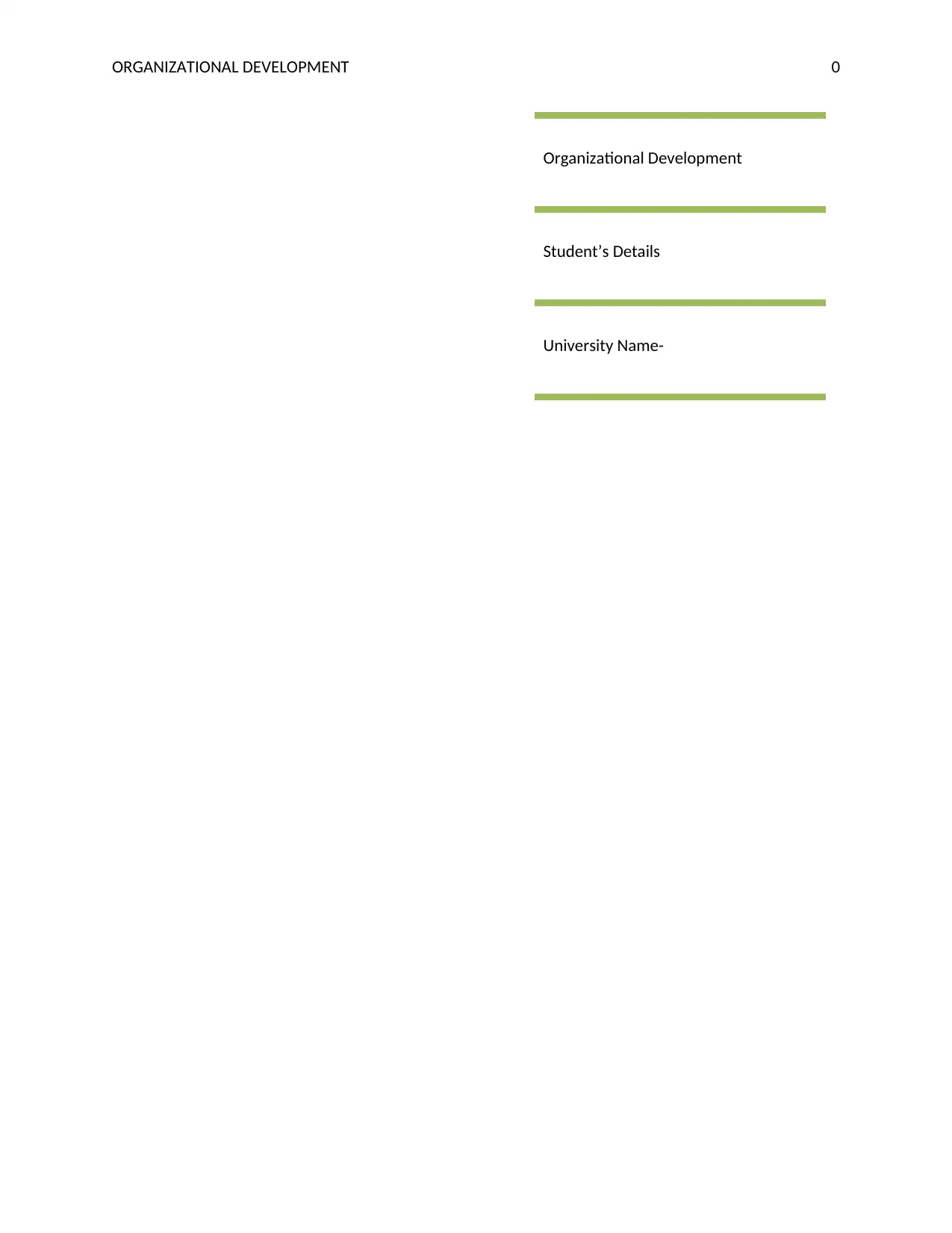
ORGANIZATIONAL DEVELOPMENT 0
Organizational Development
Student’s Details
University Name-
Organizational Development
Student’s Details
University Name-
Paraphrase This Document
Need a fresh take? Get an instant paraphrase of this document with our AI Paraphraser
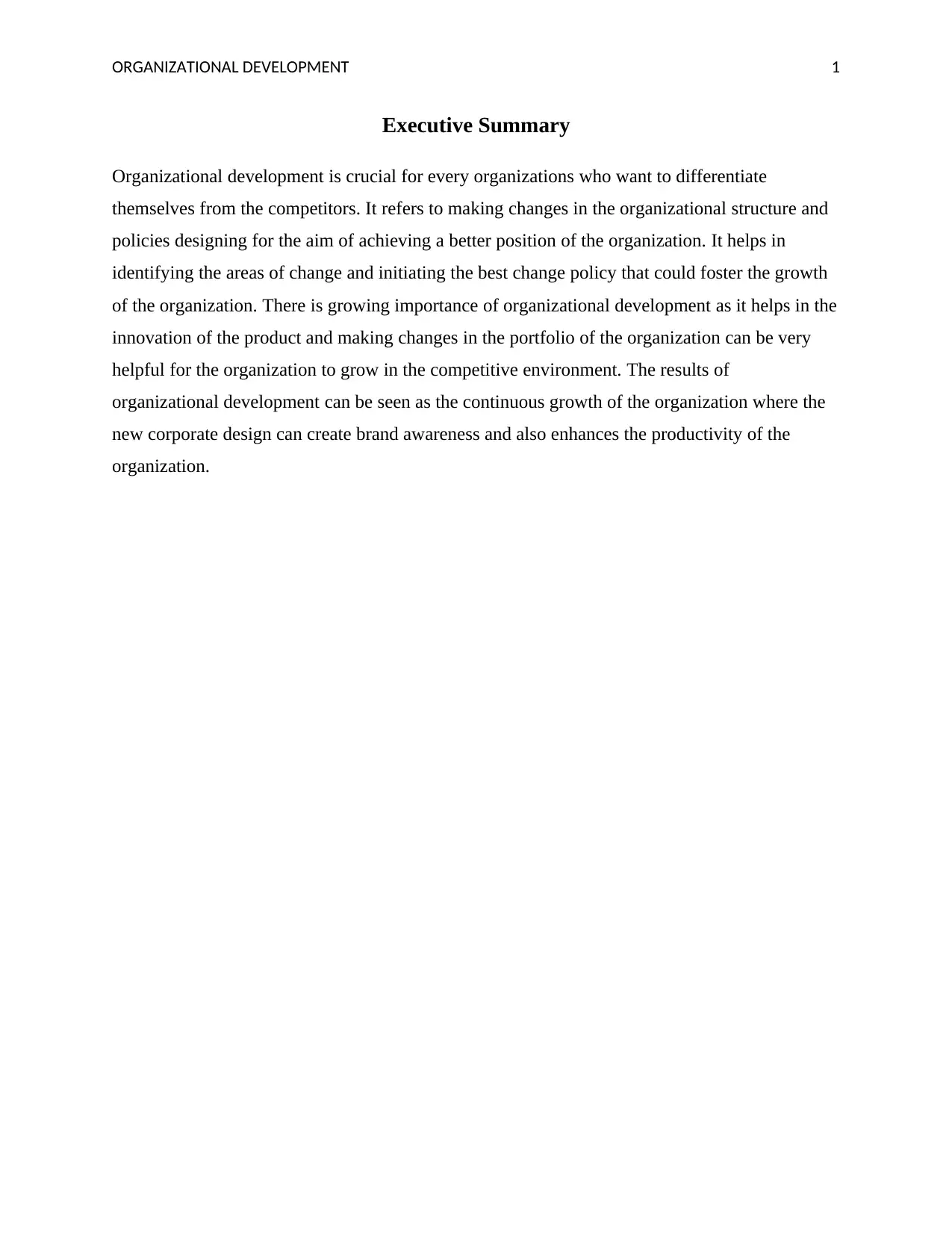
ORGANIZATIONAL DEVELOPMENT 1
Executive Summary
Organizational development is crucial for every organizations who want to differentiate
themselves from the competitors. It refers to making changes in the organizational structure and
policies designing for the aim of achieving a better position of the organization. It helps in
identifying the areas of change and initiating the best change policy that could foster the growth
of the organization. There is growing importance of organizational development as it helps in the
innovation of the product and making changes in the portfolio of the organization can be very
helpful for the organization to grow in the competitive environment. The results of
organizational development can be seen as the continuous growth of the organization where the
new corporate design can create brand awareness and also enhances the productivity of the
organization.
Executive Summary
Organizational development is crucial for every organizations who want to differentiate
themselves from the competitors. It refers to making changes in the organizational structure and
policies designing for the aim of achieving a better position of the organization. It helps in
identifying the areas of change and initiating the best change policy that could foster the growth
of the organization. There is growing importance of organizational development as it helps in the
innovation of the product and making changes in the portfolio of the organization can be very
helpful for the organization to grow in the competitive environment. The results of
organizational development can be seen as the continuous growth of the organization where the
new corporate design can create brand awareness and also enhances the productivity of the
organization.
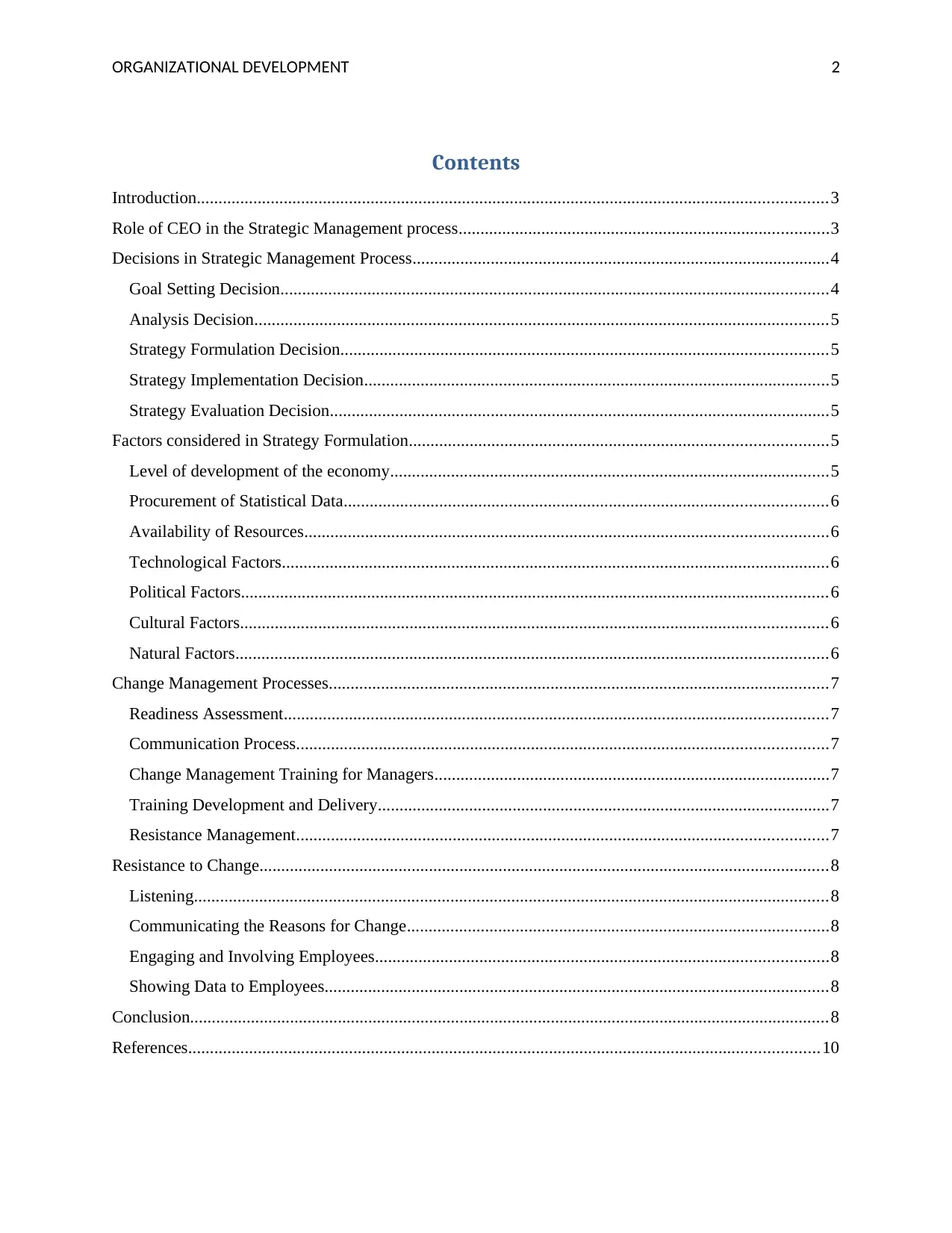
ORGANIZATIONAL DEVELOPMENT 2
Contents
Introduction.................................................................................................................................................3
Role of CEO in the Strategic Management process.....................................................................................3
Decisions in Strategic Management Process................................................................................................4
Goal Setting Decision..............................................................................................................................4
Analysis Decision....................................................................................................................................5
Strategy Formulation Decision................................................................................................................5
Strategy Implementation Decision...........................................................................................................5
Strategy Evaluation Decision...................................................................................................................5
Factors considered in Strategy Formulation................................................................................................5
Level of development of the economy.....................................................................................................5
Procurement of Statistical Data...............................................................................................................6
Availability of Resources........................................................................................................................6
Technological Factors..............................................................................................................................6
Political Factors.......................................................................................................................................6
Cultural Factors.......................................................................................................................................6
Natural Factors........................................................................................................................................6
Change Management Processes...................................................................................................................7
Readiness Assessment.............................................................................................................................7
Communication Process..........................................................................................................................7
Change Management Training for Managers...........................................................................................7
Training Development and Delivery........................................................................................................7
Resistance Management..........................................................................................................................7
Resistance to Change...................................................................................................................................8
Listening..................................................................................................................................................8
Communicating the Reasons for Change.................................................................................................8
Engaging and Involving Employees........................................................................................................8
Showing Data to Employees....................................................................................................................8
Conclusion...................................................................................................................................................8
References.................................................................................................................................................10
Contents
Introduction.................................................................................................................................................3
Role of CEO in the Strategic Management process.....................................................................................3
Decisions in Strategic Management Process................................................................................................4
Goal Setting Decision..............................................................................................................................4
Analysis Decision....................................................................................................................................5
Strategy Formulation Decision................................................................................................................5
Strategy Implementation Decision...........................................................................................................5
Strategy Evaluation Decision...................................................................................................................5
Factors considered in Strategy Formulation................................................................................................5
Level of development of the economy.....................................................................................................5
Procurement of Statistical Data...............................................................................................................6
Availability of Resources........................................................................................................................6
Technological Factors..............................................................................................................................6
Political Factors.......................................................................................................................................6
Cultural Factors.......................................................................................................................................6
Natural Factors........................................................................................................................................6
Change Management Processes...................................................................................................................7
Readiness Assessment.............................................................................................................................7
Communication Process..........................................................................................................................7
Change Management Training for Managers...........................................................................................7
Training Development and Delivery........................................................................................................7
Resistance Management..........................................................................................................................7
Resistance to Change...................................................................................................................................8
Listening..................................................................................................................................................8
Communicating the Reasons for Change.................................................................................................8
Engaging and Involving Employees........................................................................................................8
Showing Data to Employees....................................................................................................................8
Conclusion...................................................................................................................................................8
References.................................................................................................................................................10
⊘ This is a preview!⊘
Do you want full access?
Subscribe today to unlock all pages.

Trusted by 1+ million students worldwide
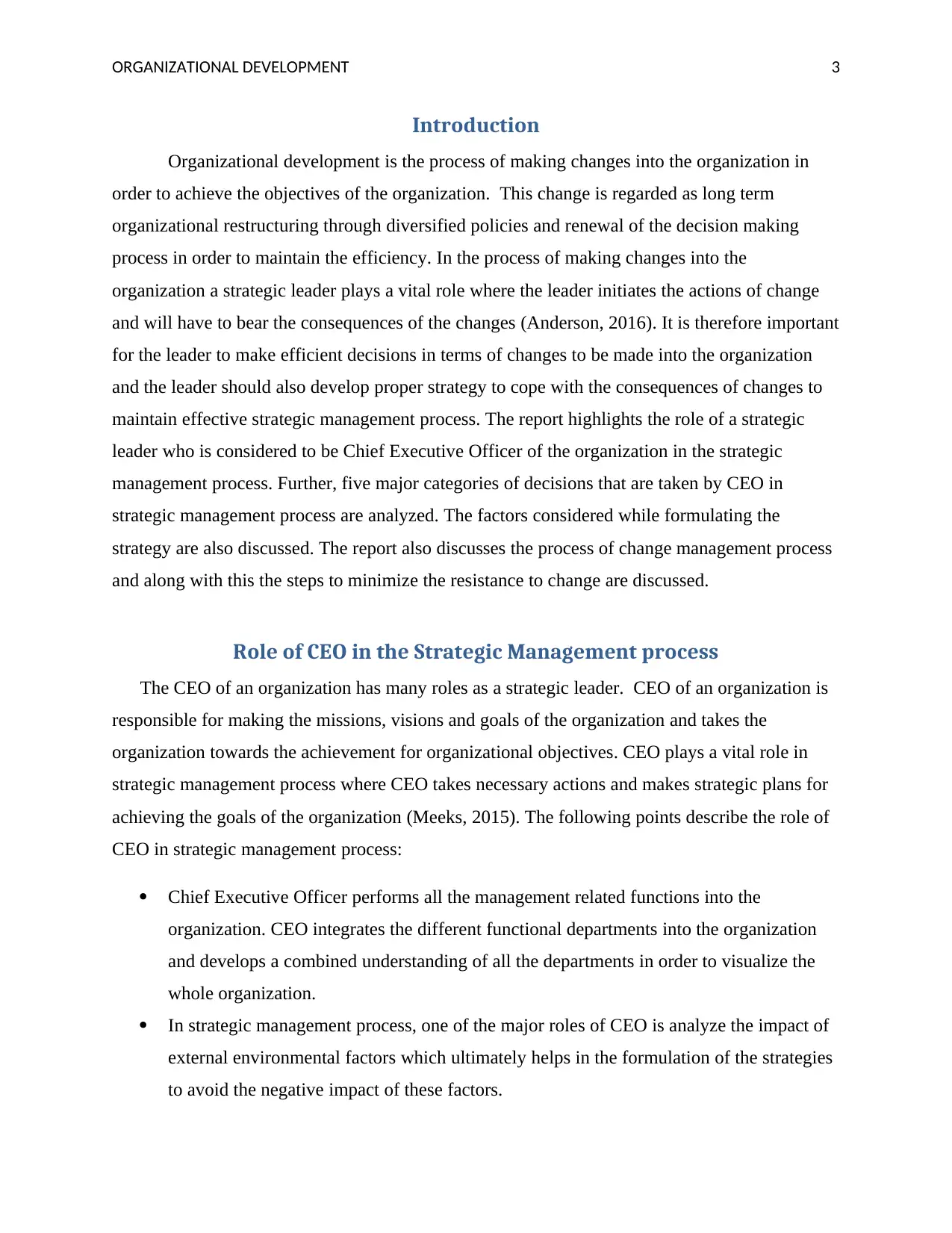
ORGANIZATIONAL DEVELOPMENT 3
Introduction
Organizational development is the process of making changes into the organization in
order to achieve the objectives of the organization. This change is regarded as long term
organizational restructuring through diversified policies and renewal of the decision making
process in order to maintain the efficiency. In the process of making changes into the
organization a strategic leader plays a vital role where the leader initiates the actions of change
and will have to bear the consequences of the changes (Anderson, 2016). It is therefore important
for the leader to make efficient decisions in terms of changes to be made into the organization
and the leader should also develop proper strategy to cope with the consequences of changes to
maintain effective strategic management process. The report highlights the role of a strategic
leader who is considered to be Chief Executive Officer of the organization in the strategic
management process. Further, five major categories of decisions that are taken by CEO in
strategic management process are analyzed. The factors considered while formulating the
strategy are also discussed. The report also discusses the process of change management process
and along with this the steps to minimize the resistance to change are discussed.
Role of CEO in the Strategic Management process
The CEO of an organization has many roles as a strategic leader. CEO of an organization is
responsible for making the missions, visions and goals of the organization and takes the
organization towards the achievement for organizational objectives. CEO plays a vital role in
strategic management process where CEO takes necessary actions and makes strategic plans for
achieving the goals of the organization (Meeks, 2015). The following points describe the role of
CEO in strategic management process:
Chief Executive Officer performs all the management related functions into the
organization. CEO integrates the different functional departments into the organization
and develops a combined understanding of all the departments in order to visualize the
whole organization.
In strategic management process, one of the major roles of CEO is analyze the impact of
external environmental factors which ultimately helps in the formulation of the strategies
to avoid the negative impact of these factors.
Introduction
Organizational development is the process of making changes into the organization in
order to achieve the objectives of the organization. This change is regarded as long term
organizational restructuring through diversified policies and renewal of the decision making
process in order to maintain the efficiency. In the process of making changes into the
organization a strategic leader plays a vital role where the leader initiates the actions of change
and will have to bear the consequences of the changes (Anderson, 2016). It is therefore important
for the leader to make efficient decisions in terms of changes to be made into the organization
and the leader should also develop proper strategy to cope with the consequences of changes to
maintain effective strategic management process. The report highlights the role of a strategic
leader who is considered to be Chief Executive Officer of the organization in the strategic
management process. Further, five major categories of decisions that are taken by CEO in
strategic management process are analyzed. The factors considered while formulating the
strategy are also discussed. The report also discusses the process of change management process
and along with this the steps to minimize the resistance to change are discussed.
Role of CEO in the Strategic Management process
The CEO of an organization has many roles as a strategic leader. CEO of an organization is
responsible for making the missions, visions and goals of the organization and takes the
organization towards the achievement for organizational objectives. CEO plays a vital role in
strategic management process where CEO takes necessary actions and makes strategic plans for
achieving the goals of the organization (Meeks, 2015). The following points describe the role of
CEO in strategic management process:
Chief Executive Officer performs all the management related functions into the
organization. CEO integrates the different functional departments into the organization
and develops a combined understanding of all the departments in order to visualize the
whole organization.
In strategic management process, one of the major roles of CEO is analyze the impact of
external environmental factors which ultimately helps in the formulation of the strategies
to avoid the negative impact of these factors.
Paraphrase This Document
Need a fresh take? Get an instant paraphrase of this document with our AI Paraphraser
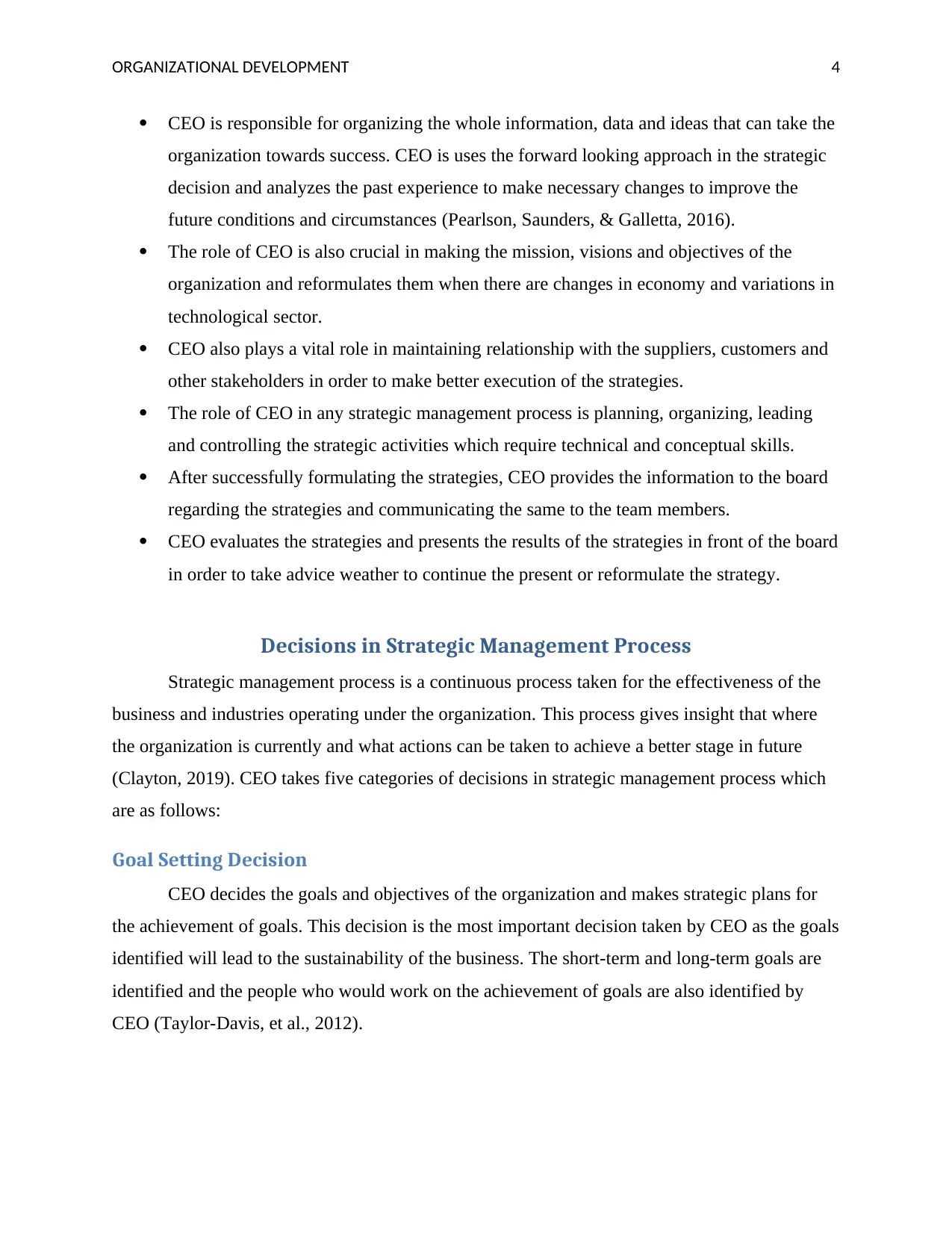
ORGANIZATIONAL DEVELOPMENT 4
CEO is responsible for organizing the whole information, data and ideas that can take the
organization towards success. CEO is uses the forward looking approach in the strategic
decision and analyzes the past experience to make necessary changes to improve the
future conditions and circumstances (Pearlson, Saunders, & Galletta, 2016).
The role of CEO is also crucial in making the mission, visions and objectives of the
organization and reformulates them when there are changes in economy and variations in
technological sector.
CEO also plays a vital role in maintaining relationship with the suppliers, customers and
other stakeholders in order to make better execution of the strategies.
The role of CEO in any strategic management process is planning, organizing, leading
and controlling the strategic activities which require technical and conceptual skills.
After successfully formulating the strategies, CEO provides the information to the board
regarding the strategies and communicating the same to the team members.
CEO evaluates the strategies and presents the results of the strategies in front of the board
in order to take advice weather to continue the present or reformulate the strategy.
Decisions in Strategic Management Process
Strategic management process is a continuous process taken for the effectiveness of the
business and industries operating under the organization. This process gives insight that where
the organization is currently and what actions can be taken to achieve a better stage in future
(Clayton, 2019). CEO takes five categories of decisions in strategic management process which
are as follows:
Goal Setting Decision
CEO decides the goals and objectives of the organization and makes strategic plans for
the achievement of goals. This decision is the most important decision taken by CEO as the goals
identified will lead to the sustainability of the business. The short-term and long-term goals are
identified and the people who would work on the achievement of goals are also identified by
CEO (Taylor-Davis, et al., 2012).
CEO is responsible for organizing the whole information, data and ideas that can take the
organization towards success. CEO is uses the forward looking approach in the strategic
decision and analyzes the past experience to make necessary changes to improve the
future conditions and circumstances (Pearlson, Saunders, & Galletta, 2016).
The role of CEO is also crucial in making the mission, visions and objectives of the
organization and reformulates them when there are changes in economy and variations in
technological sector.
CEO also plays a vital role in maintaining relationship with the suppliers, customers and
other stakeholders in order to make better execution of the strategies.
The role of CEO in any strategic management process is planning, organizing, leading
and controlling the strategic activities which require technical and conceptual skills.
After successfully formulating the strategies, CEO provides the information to the board
regarding the strategies and communicating the same to the team members.
CEO evaluates the strategies and presents the results of the strategies in front of the board
in order to take advice weather to continue the present or reformulate the strategy.
Decisions in Strategic Management Process
Strategic management process is a continuous process taken for the effectiveness of the
business and industries operating under the organization. This process gives insight that where
the organization is currently and what actions can be taken to achieve a better stage in future
(Clayton, 2019). CEO takes five categories of decisions in strategic management process which
are as follows:
Goal Setting Decision
CEO decides the goals and objectives of the organization and makes strategic plans for
the achievement of goals. This decision is the most important decision taken by CEO as the goals
identified will lead to the sustainability of the business. The short-term and long-term goals are
identified and the people who would work on the achievement of goals are also identified by
CEO (Taylor-Davis, et al., 2012).
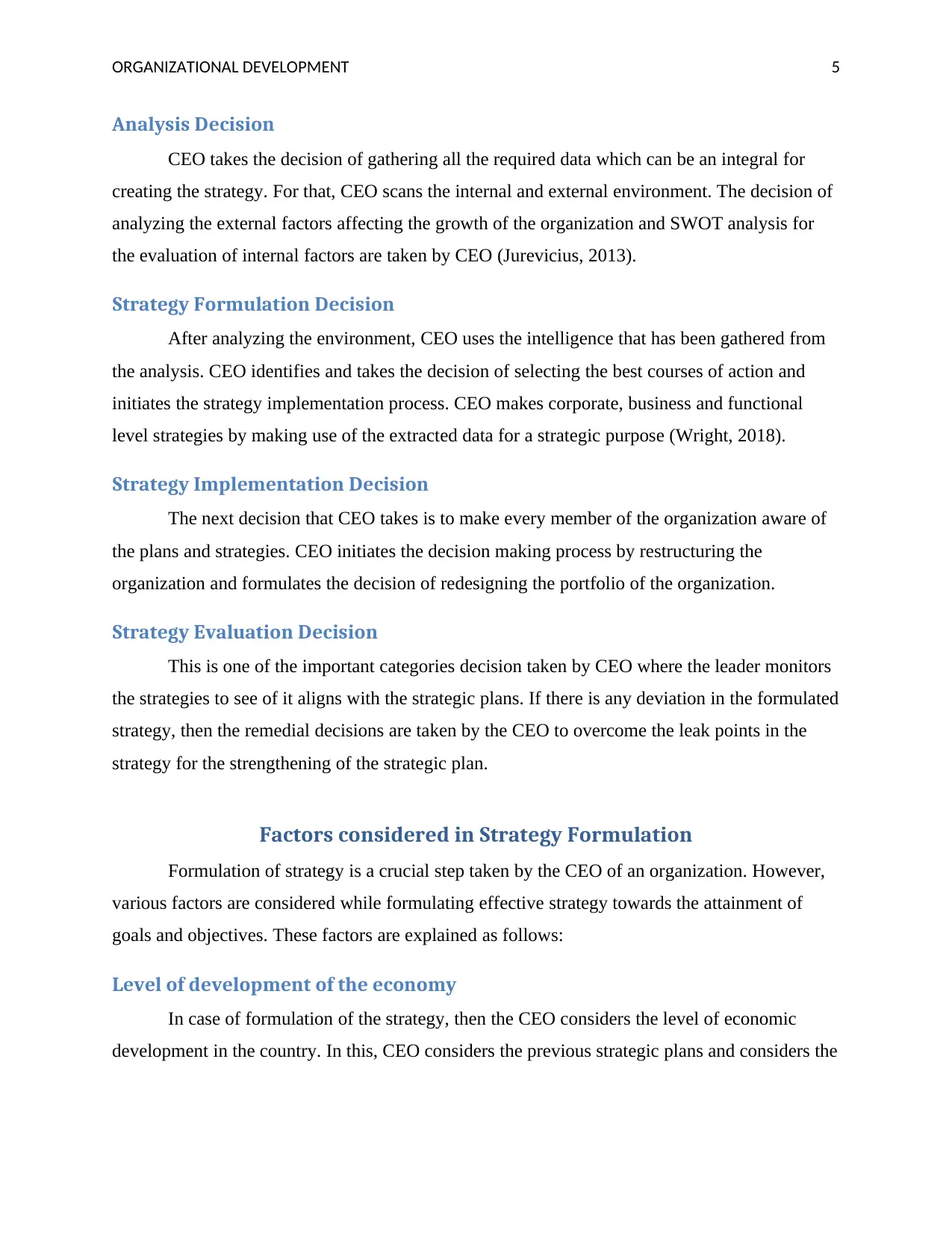
ORGANIZATIONAL DEVELOPMENT 5
Analysis Decision
CEO takes the decision of gathering all the required data which can be an integral for
creating the strategy. For that, CEO scans the internal and external environment. The decision of
analyzing the external factors affecting the growth of the organization and SWOT analysis for
the evaluation of internal factors are taken by CEO (Jurevicius, 2013).
Strategy Formulation Decision
After analyzing the environment, CEO uses the intelligence that has been gathered from
the analysis. CEO identifies and takes the decision of selecting the best courses of action and
initiates the strategy implementation process. CEO makes corporate, business and functional
level strategies by making use of the extracted data for a strategic purpose (Wright, 2018).
Strategy Implementation Decision
The next decision that CEO takes is to make every member of the organization aware of
the plans and strategies. CEO initiates the decision making process by restructuring the
organization and formulates the decision of redesigning the portfolio of the organization.
Strategy Evaluation Decision
This is one of the important categories decision taken by CEO where the leader monitors
the strategies to see of it aligns with the strategic plans. If there is any deviation in the formulated
strategy, then the remedial decisions are taken by the CEO to overcome the leak points in the
strategy for the strengthening of the strategic plan.
Factors considered in Strategy Formulation
Formulation of strategy is a crucial step taken by the CEO of an organization. However,
various factors are considered while formulating effective strategy towards the attainment of
goals and objectives. These factors are explained as follows:
Level of development of the economy
In case of formulation of the strategy, then the CEO considers the level of economic
development in the country. In this, CEO considers the previous strategic plans and considers the
Analysis Decision
CEO takes the decision of gathering all the required data which can be an integral for
creating the strategy. For that, CEO scans the internal and external environment. The decision of
analyzing the external factors affecting the growth of the organization and SWOT analysis for
the evaluation of internal factors are taken by CEO (Jurevicius, 2013).
Strategy Formulation Decision
After analyzing the environment, CEO uses the intelligence that has been gathered from
the analysis. CEO identifies and takes the decision of selecting the best courses of action and
initiates the strategy implementation process. CEO makes corporate, business and functional
level strategies by making use of the extracted data for a strategic purpose (Wright, 2018).
Strategy Implementation Decision
The next decision that CEO takes is to make every member of the organization aware of
the plans and strategies. CEO initiates the decision making process by restructuring the
organization and formulates the decision of redesigning the portfolio of the organization.
Strategy Evaluation Decision
This is one of the important categories decision taken by CEO where the leader monitors
the strategies to see of it aligns with the strategic plans. If there is any deviation in the formulated
strategy, then the remedial decisions are taken by the CEO to overcome the leak points in the
strategy for the strengthening of the strategic plan.
Factors considered in Strategy Formulation
Formulation of strategy is a crucial step taken by the CEO of an organization. However,
various factors are considered while formulating effective strategy towards the attainment of
goals and objectives. These factors are explained as follows:
Level of development of the economy
In case of formulation of the strategy, then the CEO considers the level of economic
development in the country. In this, CEO considers the previous strategic plans and considers the
⊘ This is a preview!⊘
Do you want full access?
Subscribe today to unlock all pages.

Trusted by 1+ million students worldwide
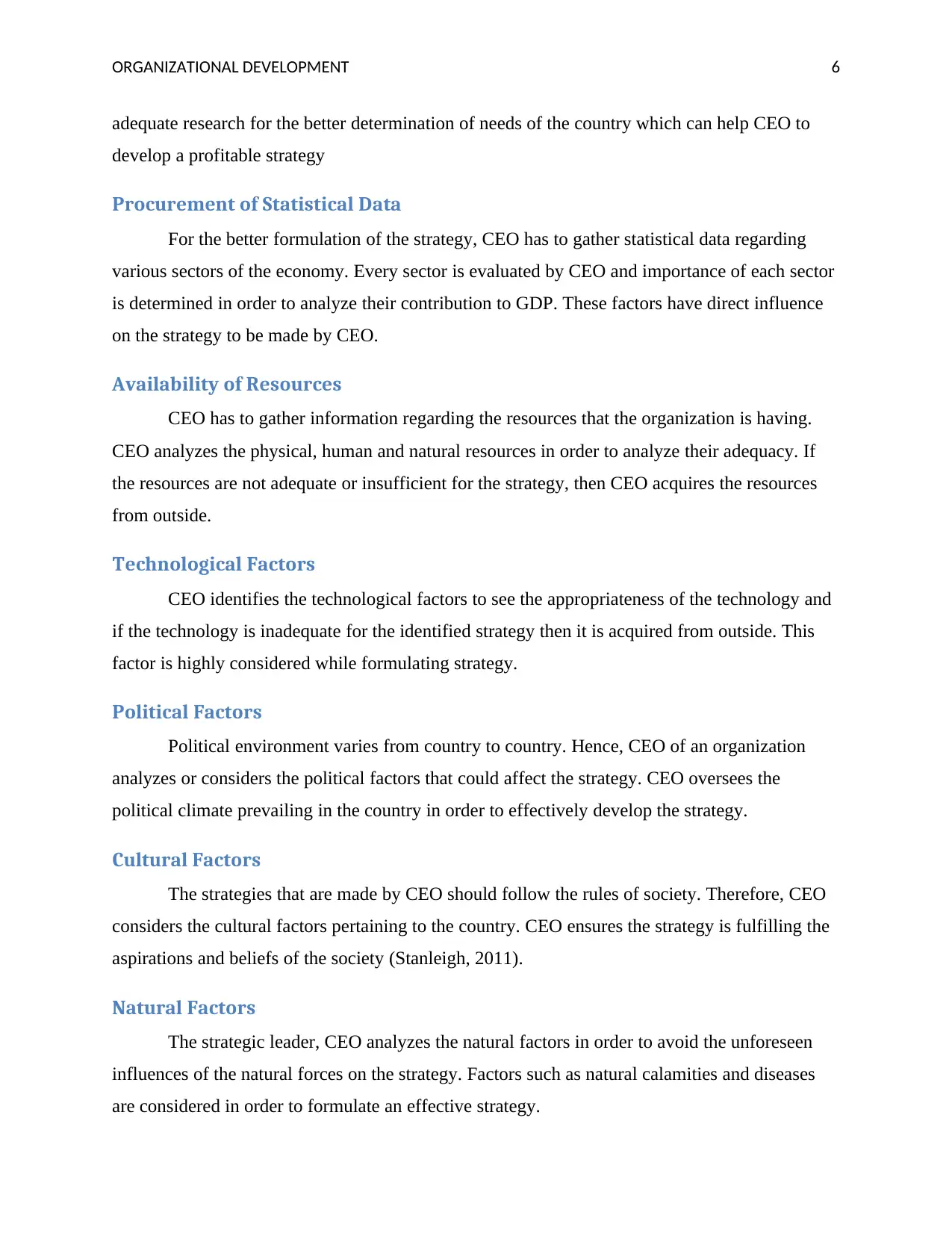
ORGANIZATIONAL DEVELOPMENT 6
adequate research for the better determination of needs of the country which can help CEO to
develop a profitable strategy
Procurement of Statistical Data
For the better formulation of the strategy, CEO has to gather statistical data regarding
various sectors of the economy. Every sector is evaluated by CEO and importance of each sector
is determined in order to analyze their contribution to GDP. These factors have direct influence
on the strategy to be made by CEO.
Availability of Resources
CEO has to gather information regarding the resources that the organization is having.
CEO analyzes the physical, human and natural resources in order to analyze their adequacy. If
the resources are not adequate or insufficient for the strategy, then CEO acquires the resources
from outside.
Technological Factors
CEO identifies the technological factors to see the appropriateness of the technology and
if the technology is inadequate for the identified strategy then it is acquired from outside. This
factor is highly considered while formulating strategy.
Political Factors
Political environment varies from country to country. Hence, CEO of an organization
analyzes or considers the political factors that could affect the strategy. CEO oversees the
political climate prevailing in the country in order to effectively develop the strategy.
Cultural Factors
The strategies that are made by CEO should follow the rules of society. Therefore, CEO
considers the cultural factors pertaining to the country. CEO ensures the strategy is fulfilling the
aspirations and beliefs of the society (Stanleigh, 2011).
Natural Factors
The strategic leader, CEO analyzes the natural factors in order to avoid the unforeseen
influences of the natural forces on the strategy. Factors such as natural calamities and diseases
are considered in order to formulate an effective strategy.
adequate research for the better determination of needs of the country which can help CEO to
develop a profitable strategy
Procurement of Statistical Data
For the better formulation of the strategy, CEO has to gather statistical data regarding
various sectors of the economy. Every sector is evaluated by CEO and importance of each sector
is determined in order to analyze their contribution to GDP. These factors have direct influence
on the strategy to be made by CEO.
Availability of Resources
CEO has to gather information regarding the resources that the organization is having.
CEO analyzes the physical, human and natural resources in order to analyze their adequacy. If
the resources are not adequate or insufficient for the strategy, then CEO acquires the resources
from outside.
Technological Factors
CEO identifies the technological factors to see the appropriateness of the technology and
if the technology is inadequate for the identified strategy then it is acquired from outside. This
factor is highly considered while formulating strategy.
Political Factors
Political environment varies from country to country. Hence, CEO of an organization
analyzes or considers the political factors that could affect the strategy. CEO oversees the
political climate prevailing in the country in order to effectively develop the strategy.
Cultural Factors
The strategies that are made by CEO should follow the rules of society. Therefore, CEO
considers the cultural factors pertaining to the country. CEO ensures the strategy is fulfilling the
aspirations and beliefs of the society (Stanleigh, 2011).
Natural Factors
The strategic leader, CEO analyzes the natural factors in order to avoid the unforeseen
influences of the natural forces on the strategy. Factors such as natural calamities and diseases
are considered in order to formulate an effective strategy.
Paraphrase This Document
Need a fresh take? Get an instant paraphrase of this document with our AI Paraphraser
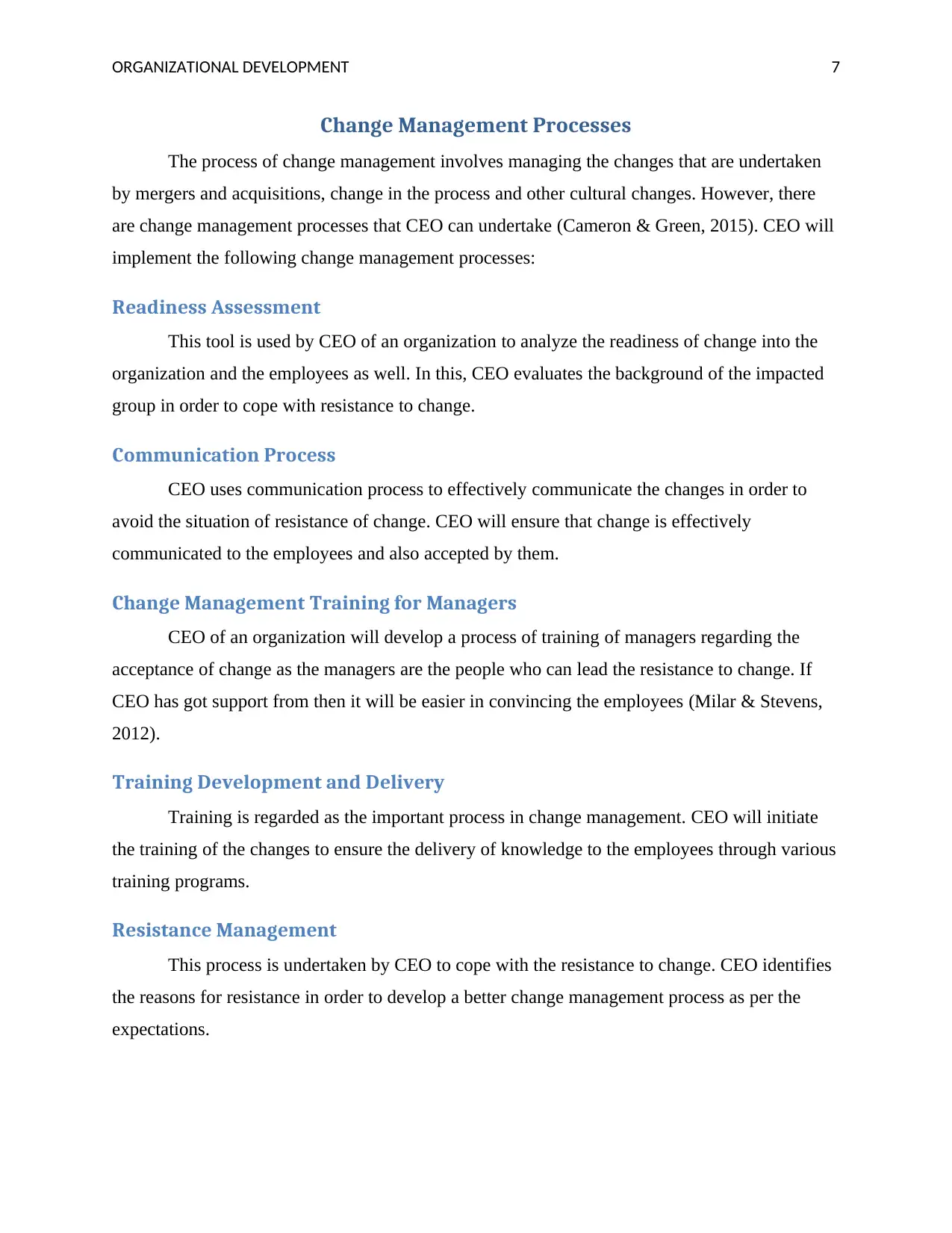
ORGANIZATIONAL DEVELOPMENT 7
Change Management Processes
The process of change management involves managing the changes that are undertaken
by mergers and acquisitions, change in the process and other cultural changes. However, there
are change management processes that CEO can undertake (Cameron & Green, 2015). CEO will
implement the following change management processes:
Readiness Assessment
This tool is used by CEO of an organization to analyze the readiness of change into the
organization and the employees as well. In this, CEO evaluates the background of the impacted
group in order to cope with resistance to change.
Communication Process
CEO uses communication process to effectively communicate the changes in order to
avoid the situation of resistance of change. CEO will ensure that change is effectively
communicated to the employees and also accepted by them.
Change Management Training for Managers
CEO of an organization will develop a process of training of managers regarding the
acceptance of change as the managers are the people who can lead the resistance to change. If
CEO has got support from then it will be easier in convincing the employees (Milar & Stevens,
2012).
Training Development and Delivery
Training is regarded as the important process in change management. CEO will initiate
the training of the changes to ensure the delivery of knowledge to the employees through various
training programs.
Resistance Management
This process is undertaken by CEO to cope with the resistance to change. CEO identifies
the reasons for resistance in order to develop a better change management process as per the
expectations.
Change Management Processes
The process of change management involves managing the changes that are undertaken
by mergers and acquisitions, change in the process and other cultural changes. However, there
are change management processes that CEO can undertake (Cameron & Green, 2015). CEO will
implement the following change management processes:
Readiness Assessment
This tool is used by CEO of an organization to analyze the readiness of change into the
organization and the employees as well. In this, CEO evaluates the background of the impacted
group in order to cope with resistance to change.
Communication Process
CEO uses communication process to effectively communicate the changes in order to
avoid the situation of resistance of change. CEO will ensure that change is effectively
communicated to the employees and also accepted by them.
Change Management Training for Managers
CEO of an organization will develop a process of training of managers regarding the
acceptance of change as the managers are the people who can lead the resistance to change. If
CEO has got support from then it will be easier in convincing the employees (Milar & Stevens,
2012).
Training Development and Delivery
Training is regarded as the important process in change management. CEO will initiate
the training of the changes to ensure the delivery of knowledge to the employees through various
training programs.
Resistance Management
This process is undertaken by CEO to cope with the resistance to change. CEO identifies
the reasons for resistance in order to develop a better change management process as per the
expectations.
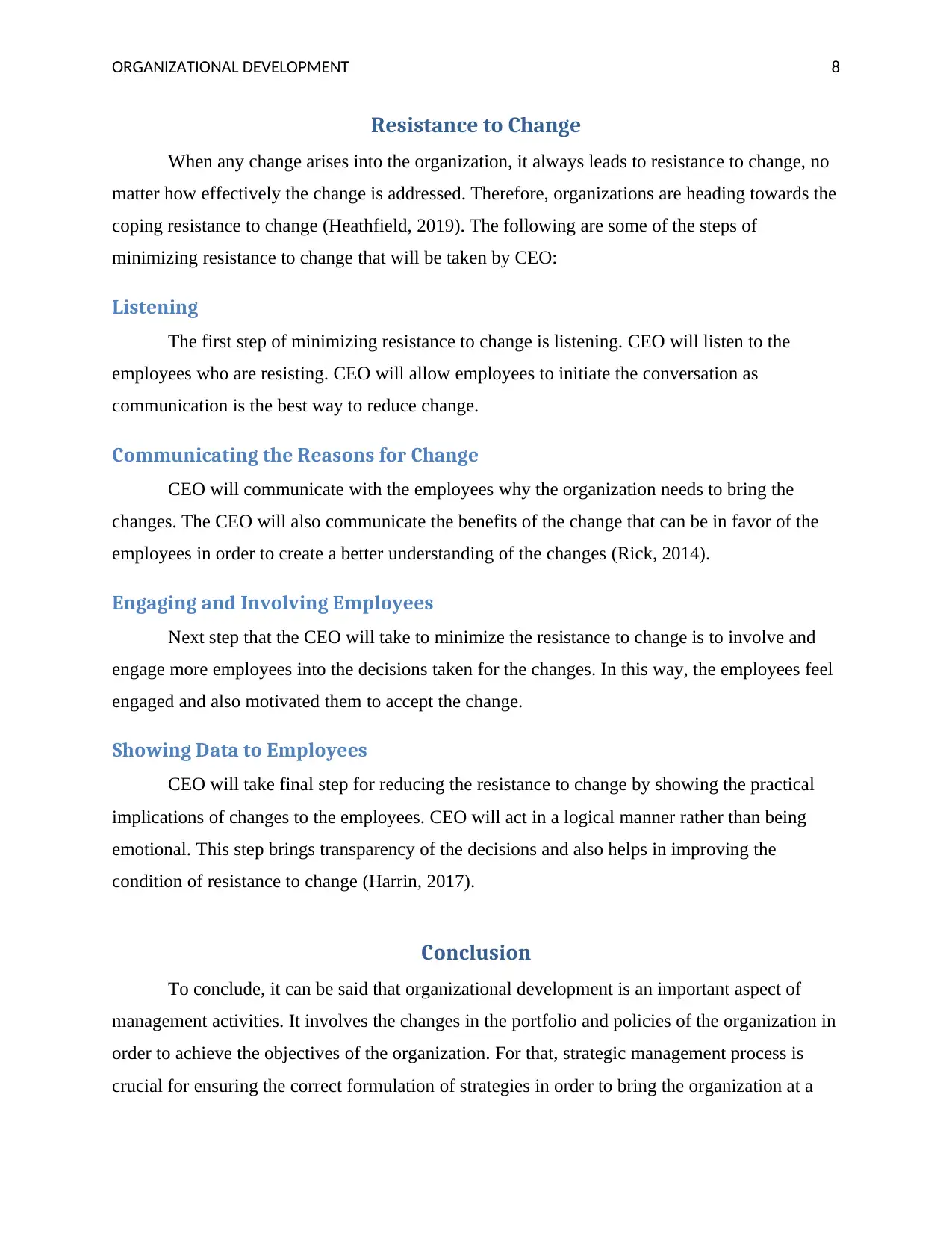
ORGANIZATIONAL DEVELOPMENT 8
Resistance to Change
When any change arises into the organization, it always leads to resistance to change, no
matter how effectively the change is addressed. Therefore, organizations are heading towards the
coping resistance to change (Heathfield, 2019). The following are some of the steps of
minimizing resistance to change that will be taken by CEO:
Listening
The first step of minimizing resistance to change is listening. CEO will listen to the
employees who are resisting. CEO will allow employees to initiate the conversation as
communication is the best way to reduce change.
Communicating the Reasons for Change
CEO will communicate with the employees why the organization needs to bring the
changes. The CEO will also communicate the benefits of the change that can be in favor of the
employees in order to create a better understanding of the changes (Rick, 2014).
Engaging and Involving Employees
Next step that the CEO will take to minimize the resistance to change is to involve and
engage more employees into the decisions taken for the changes. In this way, the employees feel
engaged and also motivated them to accept the change.
Showing Data to Employees
CEO will take final step for reducing the resistance to change by showing the practical
implications of changes to the employees. CEO will act in a logical manner rather than being
emotional. This step brings transparency of the decisions and also helps in improving the
condition of resistance to change (Harrin, 2017).
Conclusion
To conclude, it can be said that organizational development is an important aspect of
management activities. It involves the changes in the portfolio and policies of the organization in
order to achieve the objectives of the organization. For that, strategic management process is
crucial for ensuring the correct formulation of strategies in order to bring the organization at a
Resistance to Change
When any change arises into the organization, it always leads to resistance to change, no
matter how effectively the change is addressed. Therefore, organizations are heading towards the
coping resistance to change (Heathfield, 2019). The following are some of the steps of
minimizing resistance to change that will be taken by CEO:
Listening
The first step of minimizing resistance to change is listening. CEO will listen to the
employees who are resisting. CEO will allow employees to initiate the conversation as
communication is the best way to reduce change.
Communicating the Reasons for Change
CEO will communicate with the employees why the organization needs to bring the
changes. The CEO will also communicate the benefits of the change that can be in favor of the
employees in order to create a better understanding of the changes (Rick, 2014).
Engaging and Involving Employees
Next step that the CEO will take to minimize the resistance to change is to involve and
engage more employees into the decisions taken for the changes. In this way, the employees feel
engaged and also motivated them to accept the change.
Showing Data to Employees
CEO will take final step for reducing the resistance to change by showing the practical
implications of changes to the employees. CEO will act in a logical manner rather than being
emotional. This step brings transparency of the decisions and also helps in improving the
condition of resistance to change (Harrin, 2017).
Conclusion
To conclude, it can be said that organizational development is an important aspect of
management activities. It involves the changes in the portfolio and policies of the organization in
order to achieve the objectives of the organization. For that, strategic management process is
crucial for ensuring the correct formulation of strategies in order to bring the organization at a
⊘ This is a preview!⊘
Do you want full access?
Subscribe today to unlock all pages.

Trusted by 1+ million students worldwide
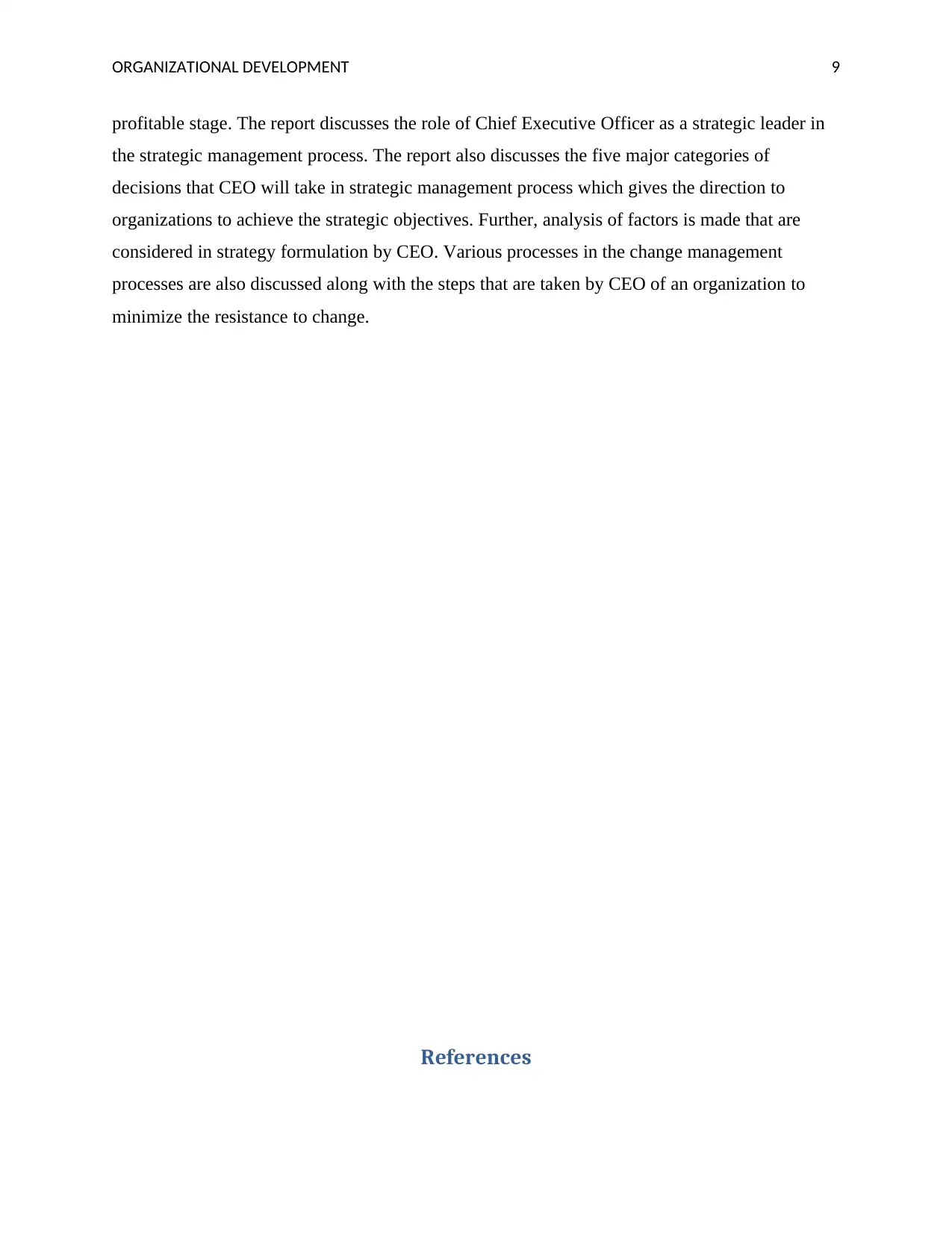
ORGANIZATIONAL DEVELOPMENT 9
profitable stage. The report discusses the role of Chief Executive Officer as a strategic leader in
the strategic management process. The report also discusses the five major categories of
decisions that CEO will take in strategic management process which gives the direction to
organizations to achieve the strategic objectives. Further, analysis of factors is made that are
considered in strategy formulation by CEO. Various processes in the change management
processes are also discussed along with the steps that are taken by CEO of an organization to
minimize the resistance to change.
References
profitable stage. The report discusses the role of Chief Executive Officer as a strategic leader in
the strategic management process. The report also discusses the five major categories of
decisions that CEO will take in strategic management process which gives the direction to
organizations to achieve the strategic objectives. Further, analysis of factors is made that are
considered in strategy formulation by CEO. Various processes in the change management
processes are also discussed along with the steps that are taken by CEO of an organization to
minimize the resistance to change.
References
Paraphrase This Document
Need a fresh take? Get an instant paraphrase of this document with our AI Paraphraser
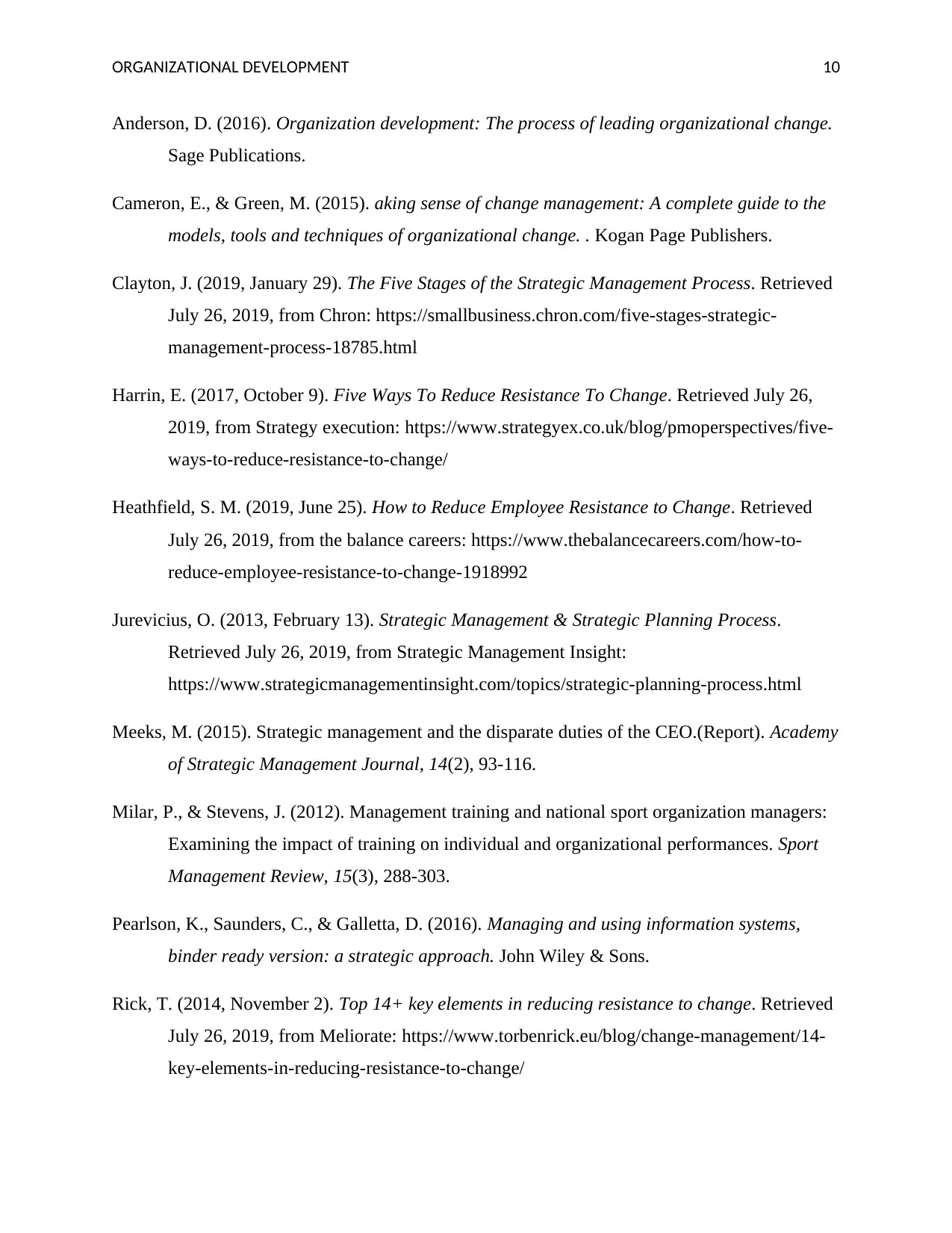
ORGANIZATIONAL DEVELOPMENT 10
Anderson, D. (2016). Organization development: The process of leading organizational change.
Sage Publications.
Cameron, E., & Green, M. (2015). aking sense of change management: A complete guide to the
models, tools and techniques of organizational change. . Kogan Page Publishers.
Clayton, J. (2019, January 29). The Five Stages of the Strategic Management Process. Retrieved
July 26, 2019, from Chron: https://smallbusiness.chron.com/five-stages-strategic-
management-process-18785.html
Harrin, E. (2017, October 9). Five Ways To Reduce Resistance To Change. Retrieved July 26,
2019, from Strategy execution: https://www.strategyex.co.uk/blog/pmoperspectives/five-
ways-to-reduce-resistance-to-change/
Heathfield, S. M. (2019, June 25). How to Reduce Employee Resistance to Change. Retrieved
July 26, 2019, from the balance careers: https://www.thebalancecareers.com/how-to-
reduce-employee-resistance-to-change-1918992
Jurevicius, O. (2013, February 13). Strategic Management & Strategic Planning Process.
Retrieved July 26, 2019, from Strategic Management Insight:
https://www.strategicmanagementinsight.com/topics/strategic-planning-process.html
Meeks, M. (2015). Strategic management and the disparate duties of the CEO.(Report). Academy
of Strategic Management Journal, 14(2), 93-116.
Milar, P., & Stevens, J. (2012). Management training and national sport organization managers:
Examining the impact of training on individual and organizational performances. Sport
Management Review, 15(3), 288-303.
Pearlson, K., Saunders, C., & Galletta, D. (2016). Managing and using information systems,
binder ready version: a strategic approach. John Wiley & Sons.
Rick, T. (2014, November 2). Top 14+ key elements in reducing resistance to change. Retrieved
July 26, 2019, from Meliorate: https://www.torbenrick.eu/blog/change-management/14-
key-elements-in-reducing-resistance-to-change/
Anderson, D. (2016). Organization development: The process of leading organizational change.
Sage Publications.
Cameron, E., & Green, M. (2015). aking sense of change management: A complete guide to the
models, tools and techniques of organizational change. . Kogan Page Publishers.
Clayton, J. (2019, January 29). The Five Stages of the Strategic Management Process. Retrieved
July 26, 2019, from Chron: https://smallbusiness.chron.com/five-stages-strategic-
management-process-18785.html
Harrin, E. (2017, October 9). Five Ways To Reduce Resistance To Change. Retrieved July 26,
2019, from Strategy execution: https://www.strategyex.co.uk/blog/pmoperspectives/five-
ways-to-reduce-resistance-to-change/
Heathfield, S. M. (2019, June 25). How to Reduce Employee Resistance to Change. Retrieved
July 26, 2019, from the balance careers: https://www.thebalancecareers.com/how-to-
reduce-employee-resistance-to-change-1918992
Jurevicius, O. (2013, February 13). Strategic Management & Strategic Planning Process.
Retrieved July 26, 2019, from Strategic Management Insight:
https://www.strategicmanagementinsight.com/topics/strategic-planning-process.html
Meeks, M. (2015). Strategic management and the disparate duties of the CEO.(Report). Academy
of Strategic Management Journal, 14(2), 93-116.
Milar, P., & Stevens, J. (2012). Management training and national sport organization managers:
Examining the impact of training on individual and organizational performances. Sport
Management Review, 15(3), 288-303.
Pearlson, K., Saunders, C., & Galletta, D. (2016). Managing and using information systems,
binder ready version: a strategic approach. John Wiley & Sons.
Rick, T. (2014, November 2). Top 14+ key elements in reducing resistance to change. Retrieved
July 26, 2019, from Meliorate: https://www.torbenrick.eu/blog/change-management/14-
key-elements-in-reducing-resistance-to-change/
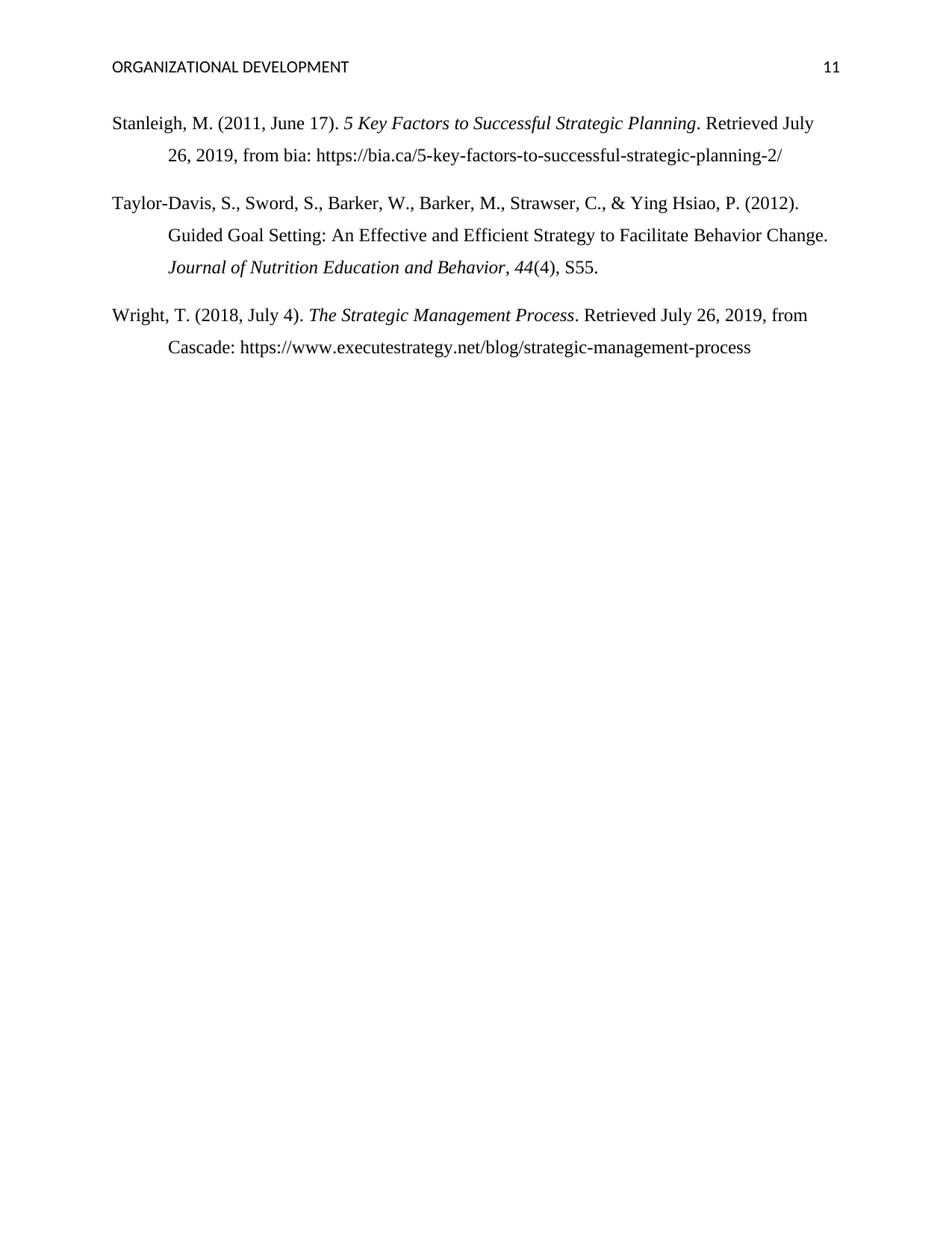
ORGANIZATIONAL DEVELOPMENT 11
Stanleigh, M. (2011, June 17). 5 Key Factors to Successful Strategic Planning. Retrieved July
26, 2019, from bia: https://bia.ca/5-key-factors-to-successful-strategic-planning-2/
Taylor-Davis, S., Sword, S., Barker, W., Barker, M., Strawser, C., & Ying Hsiao, P. (2012).
Guided Goal Setting: An Effective and Efficient Strategy to Facilitate Behavior Change.
Journal of Nutrition Education and Behavior, 44(4), S55.
Wright, T. (2018, July 4). The Strategic Management Process. Retrieved July 26, 2019, from
Cascade: https://www.executestrategy.net/blog/strategic-management-process
Stanleigh, M. (2011, June 17). 5 Key Factors to Successful Strategic Planning. Retrieved July
26, 2019, from bia: https://bia.ca/5-key-factors-to-successful-strategic-planning-2/
Taylor-Davis, S., Sword, S., Barker, W., Barker, M., Strawser, C., & Ying Hsiao, P. (2012).
Guided Goal Setting: An Effective and Efficient Strategy to Facilitate Behavior Change.
Journal of Nutrition Education and Behavior, 44(4), S55.
Wright, T. (2018, July 4). The Strategic Management Process. Retrieved July 26, 2019, from
Cascade: https://www.executestrategy.net/blog/strategic-management-process
⊘ This is a preview!⊘
Do you want full access?
Subscribe today to unlock all pages.

Trusted by 1+ million students worldwide
1 out of 12
Related Documents
Your All-in-One AI-Powered Toolkit for Academic Success.
+13062052269
info@desklib.com
Available 24*7 on WhatsApp / Email
![[object Object]](/_next/static/media/star-bottom.7253800d.svg)
Unlock your academic potential
Copyright © 2020–2025 A2Z Services. All Rights Reserved. Developed and managed by ZUCOL.





